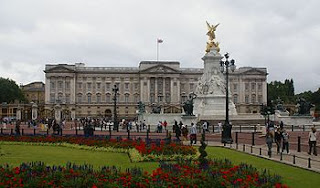Buckingham Palace
Buckingham Palace is the official London residence of the British monarch. Located in the City of Westminster, the palace is a setting for state occasions and royal entertaining, and a major tourist attraction. It has been a rallying point for the British people at times of national rejoicing and crisis.
Originally known as Buckingham House, the building which forms the core of today's palace was a large townhouse built for the Duke of Buckingham in 1703 and acquired by George III in 1761 as a private residence, known as "The Queen's House". It was enlarged over the next 75 years, principally by architects John Nash and Edward Blore, forming three wings around a central courtyard. Buckingham Palace finally became the official royal palace of the British monarch on the accession of Queen Victoria in 1837. The last major structural additions were made in the late 19th and early 20th centuries, including the present-day public face of Buckingham Palace.
The original early 19th-century interior designs, many of which still survive, included widespread use of brightly coloured scagliola and blue and pink lapis, on the advice of Sir Charles Long. King Edward VII oversaw a partial redecoration in a Belle epoque cream and gold colour scheme. Many smaller reception rooms are furnished in the Chinese regency style with furniture and fittings brought from the Royal Pavilion at Brighton and from Carlton House. The Buckingham Palace Garden is the largest private garden in London, originally landscaped by Capability Brown, but redesigned by William Townsend Aiton of Kew Gardens and John Nash. The artificial lake was completed in 1828 and is supplied with water from the Serpentine, a river which runs through Hyde Park.
The state rooms form the nucleus of the working Palace and are used regularly by Queen Elizabeth II and members of the royal family for official and state entertaining. Buckingham Palace is one of the world's most familiar buildings and more than 50,000 people visit the palace each year as guests to banquets, lunches, dinners, receptions and the royal garden parties.


0 Comments:
Post a Comment
Subscribe to Post Comments [Atom]
<< Home